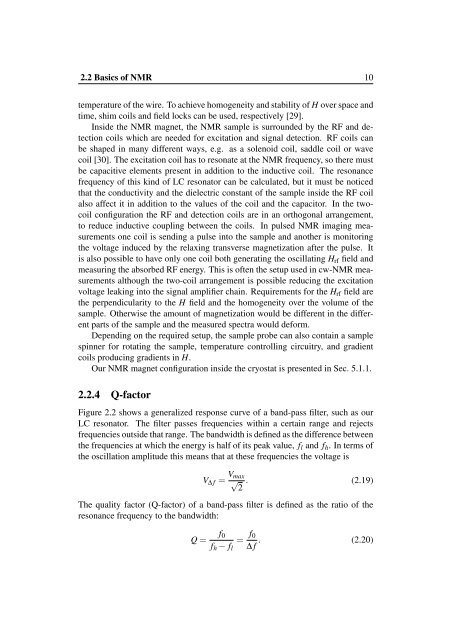NMR Techniques at Liquid Helium Temperatures - Low ...
NMR Techniques at Liquid Helium Temperatures - Low ...
NMR Techniques at Liquid Helium Temperatures - Low ...
Create successful ePaper yourself
Turn your PDF publications into a flip-book with our unique Google optimized e-Paper software.
2.2 Basics of <strong>NMR</strong> 10<br />
temper<strong>at</strong>ure of the wire. To achieve homogeneity and stability of H over space and<br />
time, shim coils and field locks can be used, respectively [29].<br />
Inside the <strong>NMR</strong> magnet, the <strong>NMR</strong> sample is surrounded by the RF and detection<br />
coils which are needed for excit<strong>at</strong>ion and signal detection. RF coils can<br />
be shaped in many different ways, e.g. as a solenoid coil, saddle coil or wave<br />
coil [30]. The excit<strong>at</strong>ion coil has to reson<strong>at</strong>e <strong>at</strong> the <strong>NMR</strong> frequency, so there must<br />
be capacitive elements present in addition to the inductive coil. The resonance<br />
frequency of this kind of LC reson<strong>at</strong>or can be calcul<strong>at</strong>ed, but it must be noticed<br />
th<strong>at</strong> the conductivity and the dielectric constant of the sample inside the RF coil<br />
also affect it in addition to the values of the coil and the capacitor. In the twocoil<br />
configur<strong>at</strong>ion the RF and detection coils are in an orthogonal arrangement,<br />
to reduce inductive coupling between the coils. In pulsed <strong>NMR</strong> imaging measurements<br />
one coil is sending a pulse into the sample and another is monitoring<br />
the voltage induced by the relaxing transverse magnetiz<strong>at</strong>ion after the pulse. It<br />
is also possible to have only one coil both gener<strong>at</strong>ing the oscill<strong>at</strong>ing Hrf field and<br />
measuring the absorbed RF energy. This is often the setup used in cw-<strong>NMR</strong> measurements<br />
although the two-coil arrangement is possible reducing the excit<strong>at</strong>ion<br />
voltage leaking into the signal amplifier chain. Requirements for the Hrf field are<br />
the perpendicularity to the H field and the homogeneity over the volume of the<br />
sample. Otherwise the amount of magnetiz<strong>at</strong>ion would be different in the different<br />
parts of the sample and the measured spectra would deform.<br />
Depending on the required setup, the sample probe can also contain a sample<br />
spinner for rot<strong>at</strong>ing the sample, temper<strong>at</strong>ure controlling circuitry, and gradient<br />
coils producing gradients in H.<br />
Our <strong>NMR</strong> magnet configur<strong>at</strong>ion inside the cryost<strong>at</strong> is presented in Sec. 5.1.1.<br />
2.2.4 Q-factor<br />
Figure 2.2 shows a generalized response curve of a band-pass filter, such as our<br />
LC reson<strong>at</strong>or. The filter passes frequencies within a certain range and rejects<br />
frequencies outside th<strong>at</strong> range. The bandwidth is defined as the difference between<br />
the frequencies <strong>at</strong> which the energy is half of its peak value, fl and fh. In terms of<br />
the oscill<strong>at</strong>ion amplitude this means th<strong>at</strong> <strong>at</strong> these frequencies the voltage is<br />
V∆ f = Vmax<br />
√2 . (2.19)<br />
The quality factor (Q-factor) of a band-pass filter is defined as the r<strong>at</strong>io of the<br />
resonance frequency to the bandwidth:<br />
Q = f0<br />
fh − fl<br />
= f0<br />
. (2.20)<br />
∆ f

















